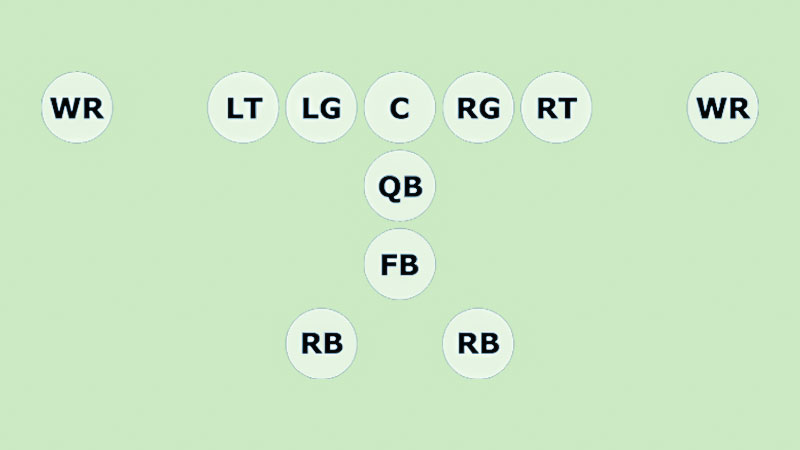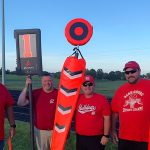In the dynamic world of American football, the wishbone offense stands out as a revolutionary formation that dominated college football in the 1970s and 1980s.
Known simply as “the bone,” this offensive scheme transformed the game with its innovative approach, focusing on a versatile quarterback who could both run and throw.
Its strategic design allowed teams to exploit defensive weaknesses, making it one of the most productive formations of its time.
The wishbone offense relies heavily on the quarterback’s decision-making and durability, requiring them to master the option play and read defenses accurately.
This formation often includes “hot calls” or audibles based on defensive alignments, particularly when an athletic tight end can create mismatches against linebackers.
By utilizing strategic routes like the Out or Curl/Comeback, the wishbone offense keeps defenses on their toes, showcasing the blend of creativity and precision that makes it a timeless strategy in football history.
Overview of the Wishbone Offense
The wishbone offense stands as a symbol of innovation in American football history, offering both versatility and power in its execution.
Historical Origins
The wishbone offense was first introduced by Emory Bellard, an assistant coach at the University of Texas, in the late 1960s. By 1969, Texas had leveraged this formation to secure back-to-back national championships.
Notably, Barry Switzer, then offensive coordinator at Oklahoma, recognized its potential and persuaded head coach Chuck Fairbanks to adopt the strategy. This move helped Oklahoma become a dominant force in college football during the 1970s.
Key Characteristics of the Wishbone Offense
The wishbone offense, a revolutionary formation in American football history, is distinguished by several defining characteristics that have made it highly effective and influential:
Formation
The wishbone offense arranges three running backs in a distinctive Y-shaped formation behind the quarterback. This configuration maximizes the options for running plays and provides a balanced threat to the defense.
Option Plays
Central to the wishbone’s strategy are option plays, where the quarterback makes decisions based on the defense’s alignment after the snap.
The quarterback can hand off the ball to the fullback diving up the middle, keep it for a run around the edge, or pitch it to one of the halfbacks trailing behind. This versatility keeps defenses guessing and allows the offense to exploit defensive vulnerabilities.
Role of Tight Ends
Tight ends in the wishbone offense play a crucial dual role. They are primary blockers in running plays, helping to open up lanes for the running backs. Additionally, tight ends are key receivers in the passing game, especially in play-action situations.
Their ability to block effectively and catch passes makes them valuable assets in creating mismatches against linebackers and safeties.
Strategic Flexibility
The wishbone offense emphasizes adaptability and strategic adjustments. Quarterbacks and coaches can use audibles and play adjustments based on the defensive alignment to capitalize on weaknesses and maintain unpredictability.
This strategic flexibility allows the offense to control the tempo of the game and dictate play execution.
Historical and Contemporary Influence
Developed in the late 1960s and popularized in the 1970s and 1980s, the wishbone offense has left a lasting legacy on football strategy.
Its innovative approach to running and option plays has influenced subsequent offensive formations and play designs across all levels of football, demonstrating the enduring impact of strategic innovation in sports.
The Basic Formation of the Wishbone Offense
The wishbone offense, known for its Y-shaped backfield, employs three running backs behind the quarterback to execute intricate option plays.
Formation
The wishbone offense positions three running backs and a quarterback in a Y-shaped configuration, designed to exploit defensive weaknesses through a variety of option plays and misdirections.
- Quarterback (QB): Central to decision-making, the QB reads the defense and executes options.
- Fullback (FB): Positioned directly behind the QB, the FB often takes the dive option and blocks.
- Halfbacks (HBs): Positioned on either side of the FB, the HBs run pitches, catch passes, and block.
- Tight Ends (TEs): Block on running plays, serve as pass options, and create mismatches.
- Offensive Line: Provides protection for the QB and creates running lanes for RBs.
Key Plays
The wishbone offense relies on several core plays that capitalize on its unique formation and player positioning:
- Fullback Dive: The QB hands off to the FB, testing the defense’s middle.
- Triple Option: The QB reads the defensive end, deciding to hand off to the FB, keep the ball, or pitch to the trailing HB.
- Option Pass: The QB fakes a run option, drawing in the defense before passing to open receivers.
- Waggle: The QB rolls out, giving the option to run or pass, often targeting a TE.
Strategic Advantages of the Wishbone Offense
The wishbone offense offers dynamic and multifaceted advantages in football. This section covers key areas where this formation excels.
Strengths in Running the Ball
The wishbone offense prioritizes running plays, leveraging the versatile positioning of three backs in a Y shape. This setup allows for option runs and misdirections that keep the defense guessing.
With tight ends providing crucial blocks, offensive plays like the Fullback Dive and Triple Option become powerfully effective. Defenses often stack the box to counter the run, but precise execution can still yield significant yardage.
Maximizing Player Talents
The wishbone offense excels in utilizing each player’s unique skills. The quarterback must be adept at decision-making for option plays. Fullbacks and halfbacks need the agility to exploit gaps in the defense.
Tight ends offer dual utility with blocking and receiving capabilities. This flexibility enables the formation to adapt to various defensive setups and creates opportunities for explosive plays like Waggle.
Variations of the Wishbone Offense
The wishbone offense has evolved over time, leading to several successful variations. These adaptations have incorporated unique strategies and formations to suit different coaching philosophies and player skill sets.
The Flexbone Variant
The Flexbone variant, derived from the Wishbone offense, focuses on speed and flexibility by replacing a traditional tight end with a wide receiver to stretch the defense horizontally.
It positions halfbacks closer to the line of scrimmage for quicker perimeter access, ideal for option plays.
Coaches like Paul Johnson and Ken Niumatalolo have successfully used the Flexbone at Georgia Tech and Navy, exploiting defensive weaknesses through motion and deception. This formation’s versatility makes it a powerful offense for teams with agile athletes.
Recent Innovations and Adaptations
Recent innovations have diversified the Wishbone offense by incorporating elements from spread and shotgun formations. Teams like Oklahoma and Clemson use the Inverted Wishbone, or Diamond formation, blending power-running principles with modern passing strategies.
This hybrid set allows for a seamless transition between power runs and play-action passes, creating mismatches and exploiting defensive vulnerabilities.
By combining the Wishbone’s traditional strengths with advanced play-calling, these adaptations have revitalized the formation, making it relevant in contemporary football and enhancing offensive unpredictability and effectiveness.
Coaching the Wishbone Offense
Coaching the wishbone offense requires understanding its unique aspects and strategic depth. Coaches must balance the intricacies of formation with the need for adaptability on the field.
Challenges and Solutions
Coaching the wishbone offense presents several challenges that coaches must address effectively to maximize its potential on the field.
Here are some common challenges and corresponding solutions:
Managing Complexity
The wishbone offense thrives on sophisticated play-calling, which requires detailed understanding from coaches and players alike.
To address this, coaches can break down plays into fundamental components during practice sessions, ensuring each player comprehends their role.
Personnel Training
Players must quickly adapt to various roles, particularly the versatile quarterback and running backs. Cross-training these key positions enhances the team’s overall agility. Incorporating drills that mimic game scenarios sharpens their decision-making under pressure.
Defensive Adaptations
Opponents frequently develop strategies to counteract the wishbone offense’s potential. To stay ahead, coaches should analyze game footage to identify defensive patterns and adjust their playbook accordingly.
Experimenting with variations like the Flexbone or Inverted Wishbone can introduce unpredictability.
Notable Teams and Coaches
Several college teams, notably Texas and Oklahoma, effectively implemented the wishbone offense, with Oklahoma’s Barry Switzer achieving significant success.
Coaches Barry Switzer and Darrell Royal are revered for their mastery of the wishbone, with Switzer’s Oklahoma Sooners winning multiple national titles and Royal leading Texas to back-to-back championships.
Frequently Asked Questions
What teams successfully used the wishbone offense?
Notable teams like the University of Texas and Oklahoma, under coaches Darrell Royal and Barry Switzer, successfully used the wishbone offense to secure national championships.
What is the role of the tight end in the wishbone offense?
The tight end in the wishbone offense plays a crucial role by providing blocking, catching passes, and creating mismatches to facilitate explosive plays.
Is the wishbone offense still used in modern football?
While the wishbone offense is less common in modern football due to the game’s evolved speed, its principles are still influential, and variations like the Flexbone are occasionally used.
What challenges do coaches face with the wishbone offense?
Coaches face challenges with the wishbone offense in managing its complexity, ensuring precise play-calling comprehension, and training personnel for versatile roles.
Did the wishbone offense lead to national championships?
Yes, the wishbone offense led Texas and Oklahoma to multiple national championships, solidifying its place in college football history.
Conclusion
The wishbone offense is a historical innovation in American football known for its strategic flexibility and precise execution. Teams like Texas and Oklahoma achieved significant success using this system, winning championships and redefining offensive play.
Although variations like the Flexbone and Inverted Wishbone have emerged, the core principles of the wishbone continue to influence modern football strategies.
Despite a decline in usage in favor of more pass-oriented schemes, the wishbone’s focus on ball control and option reads provides important lessons for coaches and players, helping create mismatches, stress defenses, and maintain possession through disciplined execution.
Despite its reduced presence in contemporary playbooks, understanding the wishbone offense equips teams with diverse tactical options. Coaches leverage its principles to develop innovative game plans, exploiting gaps in defense.








Ashley Hopkinson